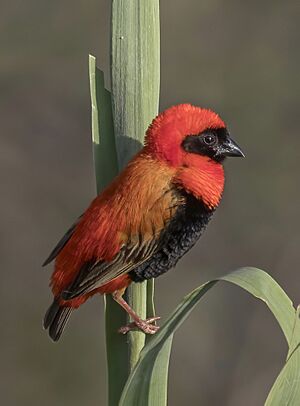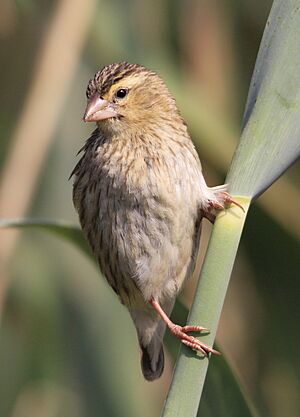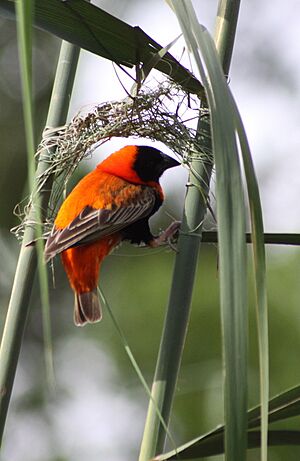Southern red bishop facts for kids
Quick facts for kids Southern red bishop |
|
|---|---|
 |
|
| Male, Zimbabwe | |
 |
|
| Female perched on a reed | |
| Conservation status | |
| Scientific classification | |
| Genus: |
Euplectes
|
| Species: |
orix
|
| Synonyms | |
|
Emberiza orix Linnaeus, 1758 |
|
The southern red bishop (Euplectes orix) is a small, colorful bird. It belongs to the same family as weavers, which are known for their amazing nests! You can find these birds in wetlands and grasslands across Africa, south of the Equator. North of the Equator, you'll find a similar bird called the northern red bishop.
Contents
How This Bird Got Its Name
Scientists like to give every living thing a special name, so they can easily talk about them. This is called taxonomy. In 1751, a British naturalist named George Edwards drew and described this bird. He called it "The Grenadier." He saw a live bird that came all the way from Angola!
Later, in 1758, a famous Swedish scientist named Carl Linnaeus gave the bird its first scientific name, Emberiza orix. Today, the southern red bishop is one of 17 species in the Euplectes group. The name Euplectes comes from ancient Greek words meaning "fine weaver," which makes sense because these birds are great at building nests! The second part of its name, orix, comes from a Latin word for "rice." This bird doesn't have any different types or subspecies.
What Does It Look Like?
The southern red bishop is about 10 to 11 centimeters long, which is pretty small! It has a thick, cone-shaped beak.
- Breeding Males: These males are super bright! They have red (sometimes orange) and black feathers. Their forehead, face, and throat are black, while the rest of their head is red. Their upper body is red, but their wings and tail are brown. Their upper chest is red, and their lower chest and belly are black.
- Non-breeding Males and Females: When it's not breeding season, the males look more like the females. They both have streaky brown feathers and are lighter underneath. Females are also a bit smaller than males.
These birds make various chirping and twittering sounds. They also have a special "nasal" (nose-like) contact call. The male's song is a buzzing sound.
The northern red bishop, a close relative, looks very similar. However, breeding males of the northern red bishop have a red throat and black feathers that go further back on their head. Their tail feathers are also longer.
Where Do They Live?
Southern red bishops live in many parts of Africa. You can find them from South Africa all the way north to Angola, and in parts of the Democratic Republic of Congo, Zambia, Uganda, Nigeria, and Kenya. They usually don't live in very dry places like the Namib Desert or the Kalahari Desert.
During the time they raise their young, they like to be near water. You'll see them among tall grasses, reeds, or even in farm fields with crops like sugar cane. When it's not breeding season, they might move to drier grasslands and savanna areas.
Life and Habits
Southern red bishops are quite social birds. They like to live in groups called colonies and search for food together in flocks. Their main diet includes seeds, but they also eat some insects. At night, they often sleep together in large groups with other birds from the weaver family.
When it's time to have babies, the male bishops get busy! They build several nests to try and attract females. They also do a special flight display, puffing up their colorful feathers to show off. One male will mate with several females.
The nests are usually built among reeds. They are carefully woven together using grasses and other plant materials. Once the nest is ready, the female will lay two to four eggs.
Images for kids




